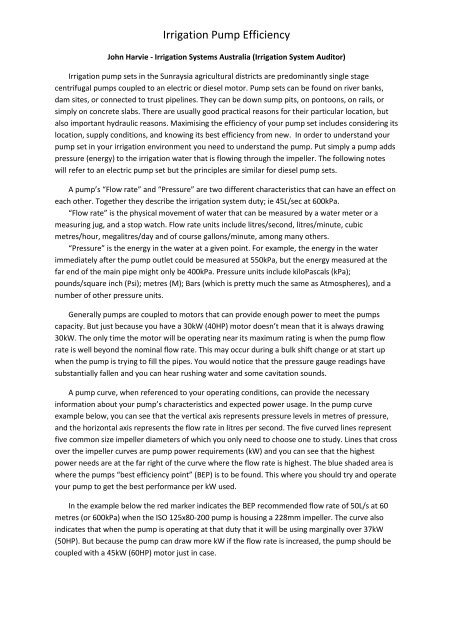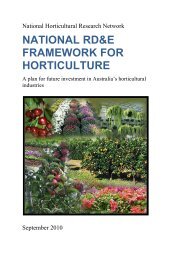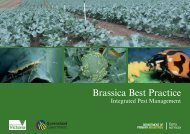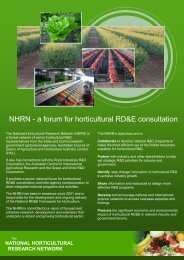Irrigation Pump Efficiency (PDF File - 568.4 KB)
Irrigation Pump Efficiency (PDF File - 568.4 KB)
Irrigation Pump Efficiency (PDF File - 568.4 KB)
Create successful ePaper yourself
Turn your PDF publications into a flip-book with our unique Google optimized e-Paper software.
<strong>Irrigation</strong> <strong>Pump</strong> <strong>Efficiency</strong>John Harvie - <strong>Irrigation</strong> Systems Australia (<strong>Irrigation</strong> System Auditor)<strong>Irrigation</strong> pump sets in the Sunraysia agricultural districts are predominantly single stagecentrifugal pumps coupled to an electric or diesel motor. <strong>Pump</strong> sets can be found on river banks,dam sites, or connected to trust pipelines. They can be down sump pits, on pontoons, on rails, orsimply on concrete slabs. There are usually good practical reasons for their particular location, butalso important hydraulic reasons. Maximising the efficiency of your pump set includes considering itslocation, supply conditions, and knowing its best efficiency from new. In order to understand yourpump set in your irrigation environment you need to understand the pump. Put simply a pump addspressure (energy) to the irrigation water that is flowing through the impeller. The following noteswill refer to an electric pump set but the principles are similar for diesel pump sets.A pump’s “Flow rate” and “Pressure” are two different characteristics that can have an effect oneach other. Together they describe the irrigation system duty; ie 45L/sec at 600kPa.“Flow rate” is the physical movement of water that can be measured by a water meter or ameasuring jug, and a stop watch. Flow rate units include litres/second, litres/minute, cubicmetres/hour, megalitres/day and of course gallons/minute, among many others.“Pressure” is the energy in the water at a given point. For example, the energy in the waterimmediately after the pump outlet could be measured at 550kPa, but the energy measured at thefar end of the main pipe might only be 400kPa. Pressure units include kiloPascals (kPa);pounds/square inch (Psi); metres (M); Bars (which is pretty much the same as Atmospheres), and anumber of other pressure units.Generally pumps are coupled to motors that can provide enough power to meet the pumpscapacity. But just because you have a 30kW (40HP) motor doesn’t mean that it is always drawing30kW. The only time the motor will be operating near its maximum rating is when the pump flowrate is well beyond the nominal flow rate. This may occur during a bulk shift change or at start upwhen the pump is trying to fill the pipes. You would notice that the pressure gauge readings havesubstantially fallen and you can hear rushing water and some cavitation sounds.A pump curve, when referenced to your operating conditions, can provide the necessaryinformation about your pump’s characteristics and expected power usage. In the pump curveexample below, you can see that the vertical axis represents pressure levels in metres of pressure,and the horizontal axis represents the flow rate in litres per second. The five curved lines representfive common size impeller diameters of which you only need to choose one to study. Lines that crossover the impeller curves are pump power requirements (kW) and you can see that the highestpower needs are at the far right of the curve where the flow rate is highest. The blue shaded area iswhere the pumps “best efficiency point” (BEP) is to be found. This where you should try and operateyour pump to get the best performance per kW used.In the example below the red marker indicates the BEP recommended flow rate of 50L/s at 60metres (or 600kPa) when the ISO 125x80-200 pump is housing a 228mm impeller. The curve alsoindicates that when the pump is operating at that duty that it will be using marginally over 37kW(50HP). But because the pump can draw more kW if the flow rate is increased, the pump should becoupled with a 45kW (60HP) motor just in case.
Best <strong>Efficiency</strong> PointArmed with information from the pump curve you can go about testing your irrigation pumpto determine whether it matches its pump curve in real life, or whether there are problems.Before you go about assessing your pump set you must ensure that you can go about itsafely. Safety issues include avoiding moving parts like a 2900RPM pump coupling, avoiding highpressure water injuries from open gauge ports, accessing pump rails and pontoons, climbing downladders into pump sumps, and other potentially injury-causing situations. It is preferable for two ormore people to be involved in assessing the pump set health and efficiency, in case safety concernsarise.The vast majority of inefficiency-causing pump problems occur because of suction issues. Ifyou constantly have to reprime your pump or find your pump has cut out due to low pressure, youmay have a faulty foot valve and a suction pipe leak. If your pump often sounds like it is pumpingstones rather than water or surging, your pump may be struggling to draw water due to being toohigh above water level. These and other issues can cause non-productive high electrical use as thepump set focuses most of its energy into drawing the water.The centrifugal pump contains an impeller that rotates quickly creating a vacuum at theimpeller eye, which in turn draws water as atmospheric pressure tries to break the vacuum with thewater. Note that if the suction pipe is not sealed properly the vacuum will be broken with air. This isknown as “losing prime”. When you prime your pump you are removing air from the impeller eye sothat the vacuum can be broken with water only, and thus create a flow of water.
Atmospheric pressure in Sunraysia is around 9.6 metres of pressure. The pump requiresanywhere from 2M to 7M of atmospheric pressure assistance, leaving the balance of availableatmospheric pressure to help overcome vertical suction height and suction pipe friction loss. This iswhy it is important to have a sealed suction pipe; to be as close to water level as possible; and havea large suction pipe and foot valve, in suction lift situations.Cavitation occurs when the vacuum at the eye of the impeller isn’t easily broken byatmospheric pressure and so pockets of vapour form and implodes causing grating sounds and inextreme cases peals surface metal off the impeller. Cavitation happens when the pump is too highvertically above the water level, or when the pump is trying to pump far more water than it wasintended to.Positive suction pressure trust supply line systems don’t experience the above problems asatmospheric pressure is not relied upon for assistance.To check whether your pump can be run more efficiently the following should be done:1. Record your pump and motor details and get a copy of the appropriate pump curve. Best toget this with the help of your irrigation design company. You will need to find the pumpmodel, the impeller diameter (if it is stamped on the plate). You will also need the motorpower rating (kW), and the RPM.2. Install pressure gauges before and after the pump. If the pump is sucking from the river ordam, you will need to install a negative pressure gauge before the pump.3. Safely begin a normal irrigation event and wait for it to pressurise fully. The aim is to nowtake a minimum of 3 pressure readings at 3 different flow rates.a. Use the water meter to measure the current full flow rate and take a pressurereading from the gauge before the pump and after the pump.b. Turn off one or two field valves (to try and halve the system flow rate), and whenthe system has fully pressurised take a reading from the gauge after the pump. Getthe new flow rate from the water meter.c. Finally close the control valve at the pump and record the pressure on the gaugeafter the pump. Also record the gauge reading before the pump. Note that yourflow rate is zero.4. Plot the results on the pump curve and see if they match. If the results vary greatly then youhave a problem and should consult your designer. Also note whether you are operating atyour best efficiency point or not.Other considerations:A variable speed drive (VSD) is a fantastic pump control device that has revolutionised theindustry over the past 15-20 years and is worth discussing in relation to power savings. In recenttimes it has become much more affordable. However it isn’t suited to every situation and in a lot ofcases it can take decades to pay for itself.A VSD is a lot like cruise control on your car. When the irrigation system starts the pumpmotorramps up to provide a softer start. The motor will continue to run at full speed until the
desired pressure setting (cruise control setting) is reached at which point the motor will slow downor speed up to maintain that pressure. Besides potential power savings other benefits include softstarting and stopping, and safety measures such as gently stopping if a low pressure setting can’t beachieved (usually due to multi-valve failures or a big pipe blow out); and if a valve or shift doesn’topen when instructed the VSD will slow down to prevent excessive pressure in the main. There areplenty of other tricks that VSD’s can be programmed to do and should be considered if you areputting in a new system, about to replace your old electrical switch gear, or are experiencing veryhigh power bills due to on-peak power use.However, VSD’s will only provide significant financial savings if you have a pump dutyrequirement below its maximum capacity. E.g. if your pump is currently struggling to provide theflow rate and pressure you need for your irrigation system, a VSD will not add more pressure, butwill in fact cause another minor drop in efficiency. If you have a pump that has a best efficiency pointat 45L/s and you are running it at only 20L/s then a VSD will not save you any significant power. (Justlike setting your cruise control for 100km/Hr but putting your transmission in only 2 nd gear).In summary maximum pump efficiency is different for different types of pumps. All you cando is try and operate the pump at the flow rate and pressure that provides the best efficiency. Youshould avoid extended periods of excessive flow during any part of your irrigation event. This is howyou can use less power and cause less wear and tear on your equipment.Consider a variable speed drive pump controller if you water during peak periods, or if youplan to operate the pump to get the best benefit.Consult with your irrigation designer and electrician to ensure that your readings areinterpreted correctly, and how best to effectively correct any poor results.






